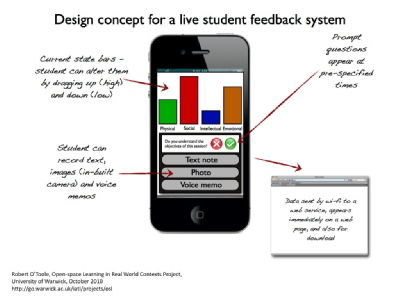All 22 entries tagged Ideation
Well ordered conceptualisations forming prototype arguments and solutions to be tested against real world situations.
View all 55 entries tagged Ideation on Warwick Blogs | View entries tagged Ideation at Technorati | There are no images tagged Ideation on this blog
October 19, 2010
Research pitch version 1
"Pitching" (writing a short and punchy summary that sells an idea) is one of the "ideation" techniques that I often recommend to students. In preparation for writing a report, and moving into the next phase of my research project, i've been using this approach with my own work. Here's my first, unsatisfactory, attempt:
My research aims to discover factors that contribute to student success in negotiating and exploiting "trans-disciplinary" and "trans-cultural" learning. My initial focus is on masters courses that are based in the arts and humanities (specifically 3 courses at Warwick), but which more freely cross methodological and cultural boundaries. I am looking at how pedagogy, space and technology supports this. But more ambitiously, I am considering how special kinds of "designerly", "theatrical" and "creative" reflexivity may empower some students to succeed by actively designing strong but agile individual and collective identities (following on from work by Margaret Archer on reflexivity and Donald Schön on "Educating the Reflective Practitioner"). In the third phase of my study, I will consider how these findings transfer and translate across to other levels (especially schools) and disciplines.
I pitched this to Jonathan Vickery, who responded with two good criticisms. Firstly, the format isn't "pitchy" enough. He says that:
"A pitch is usually formed by (i) my subject is.....(ii) my questions are; (iii) my objectives are"
Translating the generative logic of academic thinking into the convictional logic of a pitch is often difficult, but worthwile - it's a filter through which complexity passes on its way to becoming active and achievable.
Jonathan's second point leads to the reason why my pitch is still overcomplicated:
"your opening sentences 'position' the research in "trans-disciplinary" and "cross-cultural"
studies......not design"
...when design (or more specifically "designerly thinking") is the Big Idea in the research. The problem is, there are all kinds of practical and political demands impinging upon and demanding justification from my research. So, there's a feeling that there should be an immediate transfer to application in education policy making. A better research strategy is to focus upon what I am actually observing in the field, get to know that intimately, then look for implications and translations. Yesterday I attended an presentation by a representative of the AHRC on their short to medium term funding strategy. It was all a bit baffling - certainly not "pitchable" - the result of the same lack of clarity induced by too immediate concerns about justifying in terms of public policy and the greater good.
Next step - rewrite the pitch, starting with the Big Idea (my subject), translating that into a research proposal (the questions), and then saying what I hope to achieve in terms of outputs and impacts (objectives). I'll start with a bold statament proposing that there is something powerful and special about "how designers think". To justify that, i'll need to efficiently explain how they use space, technology and performance to link together collaborative action, reflexive thought and personal identity to mediate between contending (social, psychological, environmental) forces. Michael Hammond responded to my initial pitch by saying that he "gets" the space and technology dimensions, but not the "reflexive" aspect. So it's essential for me to get a good simple explanation of how it connects together. Also, I need to show how "performance" and "creative" are directly linked into "designerly".
October 12, 2010
Interview on the future of e–learning, published on the Warwick Knowledge Centre
The Knowledge Centre have published an interview with me about the future of "e-learning" at Warwick. Here's the intro:
Standardised teaching in universities, using reading lists, lectures and essays, can be seen as limiting, focusing too narrowly on training researchers. However, tailoring an ideal teaching pattern for each unique student is difficult and expensive. The newly formed Institute for Advanced Teaching and Learning (IATL) is currently developing innovative learning technologies and techniques that may help education become increasingly personalised. Robert O'Toole, E-Learning Advisor, has been evaluating their progress.
You can read the full article here.
October 11, 2010
Design for a Live Student Feedback mobile application
Here's the design I've come up with for an app for gathering feedback for teaching and learning research.
Some additional points gained from presenting this to WBS:
1. This is of much wider use in other kinds of research and commercial activity where recording granular info about participant responses is useful.
2. The feedback could be viewed live, or later for analysis.
3. If the data timeline was put alongside a video recording of the session, it would be easier to relate feedback data to actual events.
4. Allow students to download the app and use it independently, thus increasing the possible sample size for research beyond devices that we can provide to students (they can use it on their own phones etc).
Click on the image to enlarge....
 Robert O'Toole
Robert O'Toole

 Please wait - comments are loading
Please wait - comments are loading






